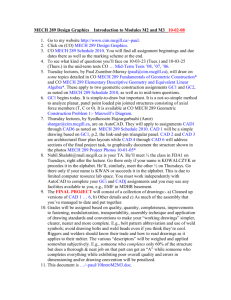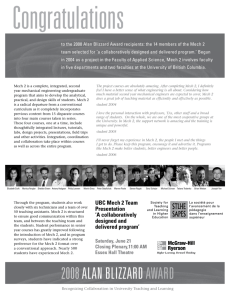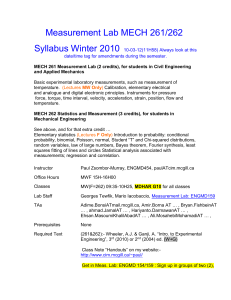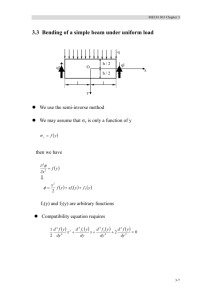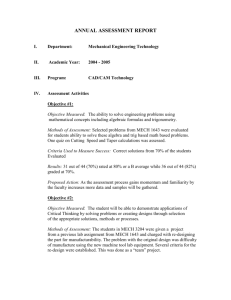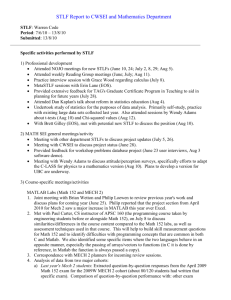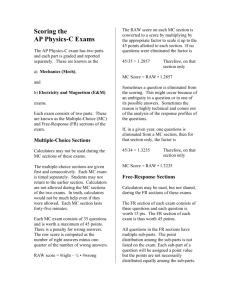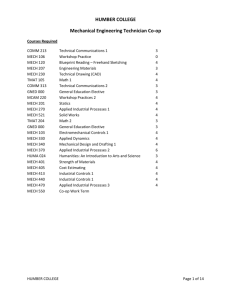Mech2_lessons_learned - Team
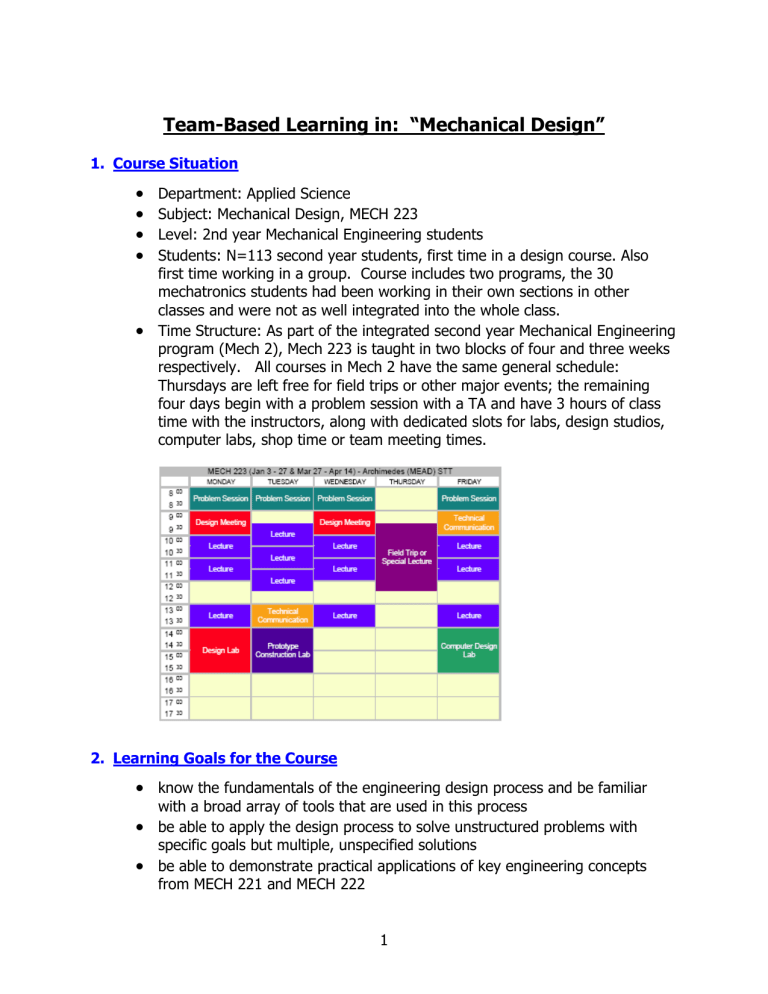
Team-Based Learning in: “Mechanical Design”
1.
Course Situation
Department: Applied Science
Subject: Mechanical Design, MECH 223
Level: 2nd year Mechanical Engineering students
Students: N=113 second year students, first time in a design course. Also first time working in a group. Course includes two programs, the 30 mechatronics students had been working in their own sections in other classes and were not as well integrated into the whole class.
Time Structure: As part of the integrated second year Mechanical Engineering program (Mech 2), Mech 223 is taught in two blocks of four and three weeks respectively. All courses in Mech 2 have the same general schedule:
Thursdays are left free for field trips or other major events; the remaining four days begin with a problem session with a TA and have 3 hours of class time with the instructors, along with dedicated slots for labs, design studios, computer labs, shop time or team meeting times.
2.
Learning Goals for the Course
know the fundamentals of the engineering design process and be familiar with a broad array of tools that are used in this process
be able to apply the design process to solve unstructured problems with specific goals but multiple, unspecified solutions
be able to demonstrate practical applications of key engineering concepts from MECH 221 and MECH 222
1
be able to demonstrate effective and professional communication skills through oral presentations and written documents
be able to work effectively in a group and develop strategies for dealing with group conflict and dysfunction
gain a better understanding of the role of an engineer as a professional in society.
3.
Reasons for Changing to Team-Based Learning
Previous way of teaching and problems encountered: traditional lecture style with some tutorials, students went off on their own for individual projects.
Found that in lectures material was readily absorbed by some students while others were sitting at the back totally disengaged. TBL reversed this process so students could cover the simplest concepts on their own and as problems became more complex they had more and more support from their teams and instructors - it sounded exciting and made sense.
Engineering is, at heart, a team-based enterprise – virtually all real engineering work is done in teams and we consider it crucial to introduce students to teamwork as early in their studies as possible.
4.
Changes Made
Larger context: The Department of Mechanical Engineering at UBC restructured its entire second year curriculum in 2004-2005 to address deficiencies associated with the conventional instructional model of numerous separate courses with a heavy lecture component. The new program, Mech
2, completely replaces a conventional course-based curriculum for the approx
120 second year students. Mech 2 is taught by a team of instructors and is fully integrated in content and delivery, aiming to foster cross-connections between the various sub-disciplines in mechanical engineering and related subjects. Courses are taught in series and mechanical design plays an important role in the new course format.
Reading guide: We spent a lot of time thinking about the readings that were the foundation for each module. We provided the students with a reading guide each week and told them which material was required, strongly recommended and of interest. We also highlighted crucial points and concepts in the text.
RAPs and Activities: We broke our seven week course into six modules, each lasting about 6-8 class hours. Our RAP quizzes included two types of questions: basic comprehension and also simple application of concepts. We chose not to include the Appeal process in the RAP due to time constraints.
We used Scantron and IF AT sheets to ensure immediate feedback; this generated a great deal of energy in the class. It took quite a bit of time to think up creative activities that students could do and that were reasonable to expect in the time we had.
2
Results (in terms of the general operation of the course): We divided the class into teams of 6-8 based on a questionnaire that took into account GPA, tool handiness, access to a car and communication skills. The class was further divided into 4 Divisions, each comprised of 5 teams. Students attended their tutorials and labs as a Division, due to space constraints. As well we structured application exercises so that the divisions were encouraged to collaborate while teams were competing with those outside their division. We offered incentives for divisions that had all teams score above a certain level.
Initially we treated tutorials (or problem sets) much the same way as in a traditional class, where students can work on more complex problems that they would not have time for in class. These problems required students to exercise judgment and the TAs were not comfortable guiding students in this role. After the first 4 week block of Mech 223 we reclassified our learning objectives for the course into Knowledge, Skills or Judgment. We continued having students develop their knowledge through the assigned readings, but we reformatted the tutorials so that students developed their skills through the problem sets in tutorial with a TA (augmented with mini-lectures of 5-20 minutes) and judgment through the team assignments (in class with an instructor).
5.
Examples of Team Assignments
We frequently had students design devices in class where each team had to come up with an argument for why their design was best and develop constructive challenges for other teams’ designs. Other activities included optimization, mathematical style problems where students applied skills from the readings and tutorials. They had to make a choice about what design was optimal. These number crunching problems were useful because if they ran into problems instructors were nearby and could quickly catch misconceptions.
One of the successful assignments we used lasted three class hours.
Students were given a crash course in mechanical components and principles of sizing them, and then asked to roughly design a mechanism for lifting a rocker arm using either a hydraulic cylinder or an electric motor. Each group was required to report the estimated cost of their device by posting their estimated cost on the board at the front of the classroom, and the mark they received was inversely related to the cost they reported.
However, before marks were assigned, there was a class discussion in which the various teams were allowed to ask questions of other teams and challenge their designs. If a team could not support its decisions in light of a challenge from another team, they were forced to withdraw their design and re-estimate their costs. The design that got the best mark was therefore the
3
one that survived challenges and had the lowest cost at the end. This marking scheme made it impossible for students to do the assignment halfheartedly – if they made poor estimates, their costs were high, and if they neglected key components, their design would be found out through challenges from other students. In general, we found that this assignment was very successful, although we did find that students are initially not all that good at explaining their designs or presenting the justifications for their decisions, so it is challenging to keep the whole class discussion at a high energy level. However, we think that presenting technical work effectively is a key professional skill and well worth developing through practice, so this is not a reason to not do these assignments.
The biggest challenge we encountered with group activities was keeping the level of energy up during the full class discussions. While students were highly engaged in team and division discussions we had difficulties transitioning to the large class discussions where only one person was talking at a time. We offered incentives for winning designs or the best solutions to problems but still need to tweak our assignments to ensure full engagement at this final stage.
6.
Impact
A.
On Student Learning and Performance:
Although comprehensive comparative data is not readily available, anecdotal evidence and exam scores suggest student understanding of the material in
MECH 223 was at least as good as in similar courses from previous years.
Students’ ability to apply class concepts to practical problems (design projects) was markedly better and the problems that the students were able to successfully solve were also much more complicated than previous years.
B.
On Student Attitudes
The course received a significantly more positive rating than non-
TBL engineering science courses in the Mech2 program when students had to rate the effectiveness of lectures/classes towards their professional development.
45%
40%
35%
30%
25%
20%
15%
10%
5%
0%
Very effective Effective Somewhat effective
Not at all effective
MECH 223 (TBL) MECH 221/2 (non-TBL)
Figure 1. Comparison of student response to MECH 223 (Team-Based Learning) and the engineering-science-based
Mech 2 courses.
4
Over 70% of students rated the TBL classes as either “effective” or “very effective” compared to 46% for the non-TBL classes. Likewise, while 7% of students rated the TBL classes as “not at all effective”, this number jumped to 13% for the non-TBL classes.
When students were asked more specifically about the use of TBL in MECH
223 (Figure 2) 60% of students ranked the course as “effective” or “very effective” for making the course more enjoyable.
50%
45%
75% of students rated the
TBL approach as being
“effective” or “very effective for developing team skills.
40%
35%
30%
25%
20%
Thus, without diminishing the learning of content, the TBL approach seems to have enhanced course enjoyment and team skills development.
15%
10%
5%
0%
Very Effective Effective Somewhat
Effective
Not at all effective
Learning course content Developing team skills Making course more enjoyable
Figure 2. Student beliefs about value of Team-Based
Learning relative to more conventional instructional modes on three criteria: course content, team skills and enjoyableness of course.
C.
On the Teacher
Overall, we are very happy with the redesign of our second year design course. The projects were considerably more complex than projects previously conducted in second year and the design process the students followed was more formally specified than it has been in the past. It was more fun, more enjoyable and there was much more interaction and connection with the students.
The use of Team-Based Learning was a revolution in the way we have traditionally taught our undergraduate courses, and for the most part we felt that it had a strong positive impact on the students and the classroom environment. Compared to a conventional design course, considerably more time and effort was required from instructors in creating in-class and tutorial activities. Care had to be taken in providing students with exercises that were sufficiently challenging yet still manageable within the time available.
As a benefit, the amount of time spent preparing lecture notes was greatly reduced. Overall, the classes were much more exciting and engaging for students and instructors alike.
5
7.
Related Publications
Hodgson, Antony J., Peter Ostafichuk and James Sibley. “Team-Based
Learning in the Design Modules of a New, Integrated, 2nd Year Curriculum at
UBC” Canadian Design Engineering Network, 2005
8.
Contact Information
Dr. Peter M. Ostafichuk, Instructor & Mech 2 Coordinator
Department of Mechanical Engineering, University of British Columbia
Mail: Room 2054-6250 Applied Sciences Lane, Vancouver, V6T 1Z4
Phone: 604-822-9614
FAX: 604-822-2403
Email: ostafichuk@mech.ubc.ca
Dr. Antony Hodgson, Associate Professor
Department of Mechanical Engineering, University of British Columbia
Mail: 2324 Main Mall, Vancouver, BC V6T 1Z4
Phone: 604 822-3240
Email: ahodgson@mech.ubc.ca
9.
APPENDIX: More Detailed Information about Team Assignments and
Products of the Teams’ Work
In addition to the in-class team exercises described above, we offered students two opportunities to closely examine a common electromechanical system – an inkjet printer. In the first session, students had been introduced to the major classes of mechanical components and were then asked to take apart the printer in order to identify how the various parts were used to accomplish various functions. In the second session, students disassembled the printer in order to assess how well the designers observed the principles of Design For Assembly.
Figure 3. ‘Hands-on’ in-class exercise – students study the mechanical components used in an inkjet printer.
Each block also features a challenging design project strongly related to the material presented in the preceding integrated module. The first project this
6
year was inspired by the Cassini-Huygens mission to Saturn and Titan. It focused on kinematics, dynamics, electronics, and materials and involved an increasingly difficult series of challenges on a two-dimensional inclined playfield. Students had to design, build, and operate a ballistically-launched vehicle (Cassini) that had to travel along the playing surface and then release a second vehicle (Huygens) towards a target. Teams were awarded points for launching automatically by referencing an electronic launch signal, for separating the Cassini and Huygens vehicles in a zone that was defined at the start of each round of competition, for having Huygens reach a target
(representing the moon Titan), and for having Cassini reach the end of the table with position and velocity appropriate for orbit around Saturn.
Score bonuses and penalties were then applied based on the weight and cost of the vehicles, and on the time required to complete the mission. A photograph from the competition is shown in Figure 4.
Figure 4. First project in MECH 223 – recreation of the Cassini-Huygens mission to Saturn and
Titan.
The second project focused on thermodynamics and fluid mechanics, and was phrased in terms of the transportation of dangerous goods by ocean-going vessels. Teams were required to design and construct a small cargo ship powered by compressed air and were awarded points based on the volume of cargo that they successfully transported through increasingly difficult maneuvers. There was a cost score based on the volume of ship as well as the amount of compressed air used. For each run, teams had to predict their time to complete the maneuver and they lost points for not making their predicted transit time. Large penalties were imposed for boats that lost cargo, became stranded, or capsized. The competition was held at a large swimming pool; a photograph picturing the winning boat is shown in
Figure 5.
Figure 5. Second project in MECH 223 – students built cargo vessels to transport bulk cargo across a pool using pressurized soda bottles as the energy source.
7
The structure of both project competitions was such that important parameters (for example, the playfield inclination in the first project) were not revealed until the beginning of a competition round. This forced teams to include adjustability in their designs and to develop and use analytical/numerical models for predicting performance. Human intervention was not permitted during the competition so teams utilized electromechanical systems for autonomous time and distance measurement, control actions, and so on.
8
